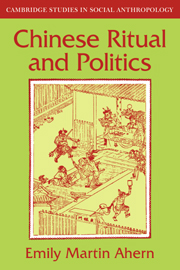Book contents
- Frontmatter
- Contents
- List of figures
- Acknowledgements
- Introduction
- Part I Interpersonal Communication
- 1 Interpersonal versus non-interpersonal transaction
- 2 Written bureaucratic communication
- 3 Etiquette and control
- Part II Codes
- Part III Politics
- Conclusions and further questions
- Notes
- Bibliography
- Character list
- Index
- CAMBRIDGE STUDIES IN SOCIAL ANTHROPOLOGY
1 - Interpersonal versus non-interpersonal transaction
Published online by Cambridge University Press: 04 March 2010
- Frontmatter
- Contents
- List of figures
- Acknowledgements
- Introduction
- Part I Interpersonal Communication
- 1 Interpersonal versus non-interpersonal transaction
- 2 Written bureaucratic communication
- 3 Etiquette and control
- Part II Codes
- Part III Politics
- Conclusions and further questions
- Notes
- Bibliography
- Character list
- Index
- CAMBRIDGE STUDIES IN SOCIAL ANTHROPOLOGY
Summary
In this chapter I argue that in order correctly to convey the sense that a Chinese ritual has for the performer, one must often distinguish actions that involve interpersonal transaction from those that do not. One source for this distinction is R.R. Marett, who sets off mechanical causation from personal or quasi-personal agency (1909: 50). My conclusion – that a distinction of this kind is essential if a description is to convey the sense a Chinese ritual act has for the performer – is implicit in Marett's work, especially in his argument with Sir James Frazer over the distinction between magic and religion. Objecting to Frazer's claim that magic involves mechanical causation, Marett contended (as I will below) that much of what we label ‘magic’ is interpersonal: ‘A magical transaction ought, hardly if at all less naturally than a religious transaction, to assume the garb of an affair between persons’ (1909: 51–2).
Another source for this distinction is Hart and Honoré's study of British and American law (1959), in which they distinguish ‘interpersonal transactions’ from ‘natural causes’ in this way: interpersonal transactions, but not natural causes, ‘involve the notion of one person intentionally providing another with a reason for doing something and so rendering it eligible in his eyes’ (p. 54). For example, one might offer bribes or rewards, or make threats or demands, to give another person a reason for performing some action. The appropriateness of this distinction in the Chinese case is brought out forcibly by a distinction that Taiwanese themselves make between illness from ‘within the body’ and illness from ‘being hit’ (chiong-tau).
- Type
- Chapter
- Information
- Chinese Ritual and Politics , pp. 9 - 15Publisher: Cambridge University PressPrint publication year: 1981

